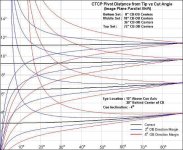Let's reverse this a little. Since people use CTE to make balls then it's impossible that it's not geometrically correct.
Because if it were not then people would not be able to make more shots, and tougher shots more consistently.
How does the geometry work?
Easy, the line that the bridge hand goes down on corresponds to the SAME line given by the invisible Ghost Ball.
Or the line shown by The Arrow
And the one shown by the Laser Guided Spider
And the same one that the B.A.T aim trainer shows
And the Otto Trainer
And the plexiglas British contraption,
And let's not forget the perfectly named, Ghost Ball Aim Trainer.....
And and and.
However by the application of CTE all one needs is the two balls as reference points. Using ONLY those two balls and the shooter can align himself to the perfect aiming line.
And how exactly does he do this?
Go to Stan Shuffet, Dave Segal, Hal Houle, Randy Goetlicher, Scott Lee or any other instructor who knows the system well enough to teach it and they will show you.
Or, go find all the free resources on the net showing the Ghost Ball diagrams and buy yourself one of the devices above or make one with a printer and some scissors or a laser cutter if you are lucky enough to have one. Then use that device to train yourself to see and eventually FEEL the proper position.
Either way, with due diligence you will learn to pocket balls with confidence.
The difference?
You can't use your Ghost Ball trainer in a match. You can only rely on your muscle memory and your "shot pictures". So if a shot comes up where you haven't hit it a million times in practice then you MIGHT have some trouble with it. I did. A lot.
But with CTE you have everything you need for any shot directly to a pocket. Yourself, the cueball and the object ball. No matter what shot comes up you can approach it the same way (or nearly the same way) and have a damn good chance of making it even if you never shot that shot before. Even if it's some weird off-angle backwards cut in the middle of the table.
THAT is the magic of CTE.
You want to know how to do it? Of course you do, who wouldn't want to be able to shoot every shot without having to practice it a milliion times first?
So what's holding you back?
Some guys who don't know HOW to do CTE, who have never learned it telling you it's impossible?
These guys who have never accomplished anything notewothry in pool telling you it's crap?
Well if it is there is only one way you will ever know for sure. You have to get on the table and figure it out.
Plenty of good people in this thread are willing to help you, but not by printing a manual here.
Here is a CTE discussion group where people who aren't interested in biting each other's heads off for ego purposes are gathered. They help each other to figure out the nuances.
http://sports.groups.yahoo.com/group/cte-students/
If you truly desire to LEARN and not be endlessly bombarded with what amounts to "is to and is not" then this is a good place to start.
Once you have learned then you can decide for yourself whether CTE fits your game or not.
The REASON that som many of us are passionate about it is really simple. We love to make balls go into the holes and CTE affords us a way to do that by giving us a way to make more shots, and to make tougher shots more consistently.
Membership in the CTE club is free. You can leave anytime. You can modify it to suit you. You can build on it and teach it to others as you are able and feel confident to do so. The only fee is time to learn and absorb it. I guarantee you as a player who has been at this game since he was 12 years old, that this is a better way to great shotmaking than spending years building a shot picture library in your head.
Or you can follow GetMeThere and see where you end up.
Your choice.
